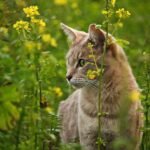Have you ever found yourself locked in a silent stare-off with your feline friend? Their eyes seem to hold secrets, mysteries, and even a dash of mischief. One moment, they’re gazing at you with soft, loving pupils, and the next, their stare is so intense it’s almost unsettling. Cat lovers everywhere have wondered: what’s really going on behind those watchful eyes? Learning to interpret your cat’s gaze can reveal a whole new layer of your bond—sometimes heartwarming, sometimes hilarious, and sometimes downright surprising. Let’s dive into the world of feline eye language and discover what your cat is trying to tell you.
The Language of Cat Eyes: More Than Meets the Eye
A cat’s eyes are mesmerizing, but there’s so much more to them than their beauty. Those glances, blinks, and lingering stares are all part of a secret language. Your cat uses its eyes to communicate everything from affection to alertness. A slow, deliberate blink might be the feline version of a kiss, a gesture of trust and love. On the other hand, an unblinking, wide-eyed stare could be your cat’s way of saying, “I’m curious about you, but I’m keeping my guard up.” Learning to decode this silent communication can deepen your relationship and help you respond to your cat’s emotional needs. Each look is like a sentence in a story your cat is eager for you to understand.
Soft Blinks: The Ultimate Cat Compliment
If your cat looks at you and slowly closes and opens its eyes, consider yourself honored. This “cat kiss” is a warm gesture, showing trust and affection. Cats rarely let their guard down, so a soft blink is a sign they feel safe and loved with you. You can even return the gesture—blink slowly back and watch your cat’s body relax. This ritual isn’t just cute; it’s the feline equivalent of a heartfelt hug. Soft blinks are a gentle reminder that your cat sees you as family, not just a food provider. Next time you’re enjoying a quiet moment together, try exchanging a few blinks and savor your special connection.
Wide Eyes: Curiosity or Caution?
A cat’s wide, open eyes can be both charming and a little mysterious. These big, round eyes often signal excitement or curiosity—maybe they’ve spotted a bird outside the window or heard the rustle of a treat bag. However, wide eyes can also indicate fear or anxiety, especially if paired with a tense body or flattened ears. Cats are experts at hiding their feelings, but their eyes can betray their true emotions. If your cat’s eyes are wide and their pupils are dilated, pay attention to what’s happening around them. Sometimes, the world is just a little too interesting—or a bit too overwhelming.
Unblinking Stares: A Test of Trust or Territory?
Ever feel like your cat is staring straight into your soul? A direct, unblinking stare can mean several things in cat language. In some cases, it’s a sign of trust and confidence—they feel comfortable enough to watch you closely without fear. But in the animal kingdom, staring can also be a sign of dominance or even a warning. If your cat’s body is tense and their tail is flicking, they might be feeling territorial or challenged. Understanding the difference requires looking at the whole picture—what’s happening in the room, and how is your cat’s body positioned? Sometimes, a stare is just a stare; other times, it’s a silent conversation about boundaries.
Pupil Changes: Reading Their Emotional State
Your cat’s pupils are like emotional barometers. Narrow, slit-like pupils often mean your cat feels relaxed or focused, perhaps watching you with quiet contentment. But when those pupils suddenly widen, it can signal excitement, fear, or even aggression. Lighting plays a role too, but emotional shifts are usually easy to spot once you know what to look for. For example, during playtime, your cat’s pupils may dilate as they stalk a toy, mimicking the thrill of the hunt. On the flip side, if your cat is startled by a loud noise, you’ll likely see those pupils shoot wide open. Paying attention to these subtle changes can help you tune in to your cat’s mood and respond with empathy.
Half-Closed Eyes: Signs of Contentment and Sleepiness
When your cat’s eyelids droop and they peer at you through half-closed eyes, it’s a sign they feel utterly at ease. This drowsy, lazy gaze is common during cuddle sessions or after a good meal. It’s the look of pure relaxation, signaling that your cat feels safe and unthreatened. In the wild, cats only let their guard down around those they trust, so a sleepy stare is a high compliment. You might even notice your cat purring softly or kneading their paws—a sure sign they’re in their happy place. So, next time your cat gives you that dreamy look, know they’re sharing a peaceful moment with you.
Eye Contact in Cat-to-Cat Communication
Cats use eye contact not just with humans, but with each other. In a multi-cat household, you might notice your cats exchanging glances to set boundaries or express affection. A dominant cat may hold a steady gaze to assert their place, while a more submissive cat will look away or blink to show respect. Playful kittens often engage in exaggerated blinks or squinty eyes to signal their intentions. Watching your cats interact can teach you a lot about their social dynamics and help prevent misunderstandings. By observing these subtle cues, you can foster harmony and resolve tensions before they escalate.
When to Worry: Medical Issues Behind Watchful Eyes
While your cat’s eyes are usually windows to their soul, sometimes a change in their gaze can signal health problems. Watery eyes, excessive blinking, or unusual redness might indicate an infection or injury. If your cat’s eyes suddenly look different—cloudy, swollen, or persistently dilated—it’s important to consult your veterinarian. Eye issues can develop quickly in cats and may lead to serious complications if left untreated. Paying close attention to changes in your cat’s eyes can help you catch problems early and ensure your feline friend stays healthy and comfortable. Always trust your instincts; if something seems off, it’s better to be safe than sorry.

Growing up traveling and experiencing new cultures and wonders, I have had a passion for nature, adventuring, photography, and videography. I am currently working towards a BSc in Biodiversity and Ecology at Stellenbosch University, and I hope to specialise in Marine Sciences one day.
Please send any feedback to Feedback@animalsaroundtheglobe.com






